| 2 September |
• yesterday • tomorrow |
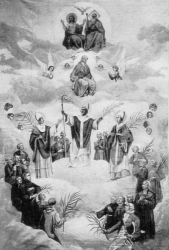
• Martyrs of Paris
• Martyrs of Carmes
A group of 191 martyrs who died in the French Revolution. They were imprisoned in the Abbey of St-Germain-des-Prés, Hôtel des Carmes in the rue de Rennes, Prison de la Force, and Seminaire de Saint-Firmin in Paris, France by the Legislative Assembly for refusing to take the oath to support the civil constitution of the clergy. This act placed priests under the control of the state, and had been condemned by the Vatican. They include -
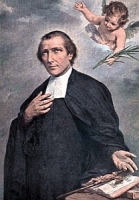
• Guillaume-Nicolas-Louis Leclerq
• Nicholas Leclerq
• Salomon Leclerq
• Salomone LeClercq
• Solomon Leclerq
Son of a wealthy French wine merchant. Though his father wanted him to pursue the family business, Nicholas early discerned a call to religious life. On 25 March 1767, he entered the novitiate of the Brothers of Christian Schools, and took the name Solomon. A good student, recognized for his piety and deep prayer life, Brother Solomon spent several years teaching at various schools throughout France, and witnessed much of the political turmoil tearing his country apart. He served as director of novices for his community, and was a frequent correspondent with his brothers and sisters on matters spiritual. Procurator in the Congregation's motherhouse, and worked as secretary to the superior general of the Order. In the summer of 1792, Brother Solomon, along with many other priests and religious, was imprisoned, and martyred as part of the suppression of Christianity of the French Revolution. He was the first martyr of the Brothers of Christian Schools.
14 November 1745 in Boulogne-ser-Mer, Pas-de-Calais, France as Nicholas
2 September 1792 at the garden of the Hôtel des Carmes Carmelite convent at Paris, France
16 October 2016 by Pope Francis
As for us, we hold to what we believed ten and twenty years ago; to what our forefathers believed one hundred years ago, and one thousand years ago, and to that which the whole Catholic world has always believed. - Brother Solomon Le Clerq
One of nine children born to Joseph-François Pey, a physician, and Marguerite Rose Moutte; five of these died in childhood. Theirs was a pious family; both François-Joseph and his older brother, Jean-Louis, became priests. François-Joseph studied at seminaries in Aix-en-Provence, then Paris, and then Trier. Ordained a priest on 10 August 1784 in the archdiocese of Trier, he returned to Paris where he served as chaplain at the College Sainte-Barbe. At the same time, he studied at the Sorbonne, and obtained a Master's degree on 11 October 1785, and a doctorate on 16 January 1787. Noted as a Bible scholar.
François-Joseph was chosen canon of the cathedral in Paris on 19 March 1787, but considered such a post to be a way that made the priesthood into a career insted of the life of service to God that he sought. Appointed vicar of the parish of Saint-Landry on the Ile de la Cité in Paris on 15 July 1788, he served as sacristan and treasurer. Chosen an elector of deputies to the legislature on 23 April 1789, he helped document the grievances of the working classes in Paris.
In January 1791, the government of the French Revolution ordered all priests to take an oath of loyalty to the civil constitution; Father Pey refused. On 10 August 1791 he was arrested for this, imprisoned without the formality of a trial, and when he refused to change his mind or desert the other objecting priests, he was murdered.
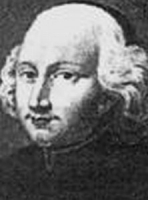
Father Alexander Charles Lanfant
Born to a middle-class family, Alexandre studied at Trinity College in Lyon, France, then became a Jesuits novice on 7 September 1741 at age 15 in Avignon, France. He taught grammar, rhetoric and humanities in several schools in the French cities of Aix, Besancon and Marseille, studying theology all the while. Ordained a priest in 1759. He made his solemn profession in the Jesuits in 1760 Macon, France, and soon became a noted preacher of parish missions in the region of Nancy, France.
When the Jesuits were suppressed in France in 1762, Father Alexandre was able to continue his priestly ministry under the protection of the Duke Stanislaus I of Lorraine. Upon the death of the duke, Father Alexandre travelled to Vienna, Austria where he served as preacher in the court of Empress Maria Theresa. In 1789 he returned to Paris, France, where he served for two years as confessor to King Louis XVI, and became the target of the enmity of the Jansenists.
Alexandre was arrested in August 1792 in the persecutions of the French Revolution for his faith, his priesthood, his refusal to take the oath to the civil constitution, and the assumed influence he had over the king.
Born to the French nobility, the son of Pierre Symphorien de Pazery, a knight, the lord of Thorame, and councilor to the French parliament, and of Catherine Lordonne; Jules was baptized at the age of one day. He earned as Master's degree in Paris, France on 17 February 1784, and studied at the San-Sulpice seminary, being ordained a priest in 1788. He earned a doctorate from the Sorbonne, and served as vicar-general to the bishop of Toulon, France. When the bishop was exiled to Italy during the persecutions of the French Revolution, Father Jules administered the diocese. When his see was suppressed, he returned to Paris on 1 April 1792. On 11 August 1792, he was arrested by the Revolutionary authorities as part of their anti-Catholic persecutions.
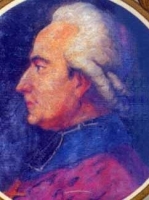
Born to the French nobility, the son of the lord of Maumont Jean de La Rochefoucauld and Marguerite des Escots; his brother Francois-Joseph became bishop of Beauvais, France, and his sister was abbess of the convent of Notre Dame de Soissons. Priest. Prior commendator of Nanteuil, France in 1770. Chosen general agent of the clergy in 1775. Bishop of Saintes, France in 1781. Organized a bank that functioned like modern fire insurance. Elected deputy of the clergy to the general states for the Sénéchaussée de Saintes on 24 March 1789. One of the Martyrs of September, killed in the anti–Christian excesses of the French Revolution.
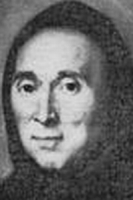
Ambrosius, Ambrose, Ambrogio
Ambroise-Augustin joined the Benedictine Maurist abbey of Saint-Florent de Saumur in Orléans, France on 14 May 1744 at the age of 16. He was later sent to the Saint-Germain-des-Prés Abbey in Paris, France. Beginning in 1763, he began to be appointed to leadership positions, and in 1783 was chosen the superior-general of the French Maurists; he was the last person to hold the position. Arrested in August 1792 and imprisoned with other clerics at the Carmelite monastery in Paris, France in the persecutions of the French Revolution, he became one of the Martyrs of September.
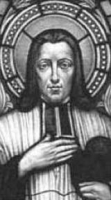
Immigrant from Canada to France where he served as a priest in the archdiocese of Sens and canon of the cathedral there. During the persecutions of the French Revolution, he was arrested and murdered for refusing to take an oath of allegiance to civil constitution.
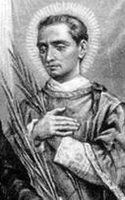
Brother of Blessed Charles-Louis Hurtrel. He studied in the seminaries of Trente-Trois and Saint-Nicolas in the archdiocese of Paris, France. Diocesan deacon.
Priest in the diocese of Orléans, France.
Priest in the archdiocese of Paris, France.
Santino
Priest in the diocese of Versailles, France.
Priest of the archdiocese of Paris, France.
• Andé Angar • André-Abel Alricy • Antoine-Charles-Octavien du Bouzet • Antoine-Mathieu-Augustin Nogier • Apollinaris of Posat • Armand de Foucauld de Pontbriand • August-Dénis Nezel • Bernard-François de Cucsac • Bertrand-Antoine de Caupenne • Charles Carnus • Charles-François le Gué • Charles-Jéremie Bérauld du Pérou • Charles-Louis Hurtrel • Charles-Regis-Mathieu de la Calmette de Valfons • Charles-Victor Véret • Claude Bochot • Claude Cayx-Dumas • Claude Chaudet • Claude Colin • Claude Ponse • Claude Rousseau • Claude-Antoine-Raoul Laporte • Claude-François Gagnières des Granges • Claude-Louis Marmotant de Savigny • Claude-Silvain-Raphaël Mayneaud de Bizefranc • Denis-Claude Duval • Éloy Herque du Roule • Étienne-François-Dieudonné de Ravinel • Étienne-Michel Gillet • Eustache Félix • François Balmain • François Dardan • François Dumasrambaud de Calandelle • François Lefranc • François Varheilhe-Duteil • François-César Londiveau • François-Hyacinthe lé Livec de Trésurin • François-Joseph de la Rochefoucald-Maumont • François-Joseph Monnier • François-Louis Hébert • François-Louis Méallet de Fargues • François-Urbain Salins de Niart • Gabriel Desprez de Roche • Gaspard-Claude Maignien • Georges Girault • Georges-Jérôme Giroust • Gilbert-Jean Fautrel • Gilles-Louis-Symphorien Lanchon • Guillaume-Antoine Delfaut • Henri-August Luzeau de la Mulonnière • Henri-Hippolyte Ermès • Henri-Jean Milet • Jacques de la Lande • Jacques Dufour • Jacques Friteyre-Durvé • Jacques-Alexandre Menuret • Jacques-Augustin Robert de Lézardières • Jacques-étienne-Philippe Hourrier • Jacques-François de Lubersac • Jacques-Gabriel Galais • Jacques-Jean Lemeunier • Jacques-Joseph Le jardinier desLandes • Jacques-Jules Bonnaud • Jacques-Léonor Rabé • Jacques-Louis Schmid • Jean Charton de Millou • Jean Goizet • Jean Lacan • Jean Lemaître • Jean-André Capeau • Jean-Antoine Guilleminet • Jean-Antoine Savine • Jean-Antoine Seconds • Jean-Antoine-Barnabé Séguin • Jean-Antoine-Hyacinthe Boucharenc de Chaumeils • Jean-Antoine-Joseph de Villette • Jean-Baptiste Bottex • Jean-Baptiste Jannin • Jean-Baptiste Nativelle • Jean-Baptiste-Claude Aubert • Jean-Baptiste-Marie Tessier • Jean-Baptiste-Michel Pontus • Jean-Charles Caron • Jean-Charles Legrand • Jean-Charles-Marie Bernard du Cornillet • Jean-François Bonnel de Pradal • Jean-François Bousquet • Jean-François Burté • Jean-François-Marie Benoît-Vourlat • Jean-Henri Gruyer • Jean-Henri-Louis-Michel Samson • Jean-Joseph de Lavèze-Bellay • Jean-Joseph Rateau • Jean-Louis Guyard de Saint-Clair • Jean-Marie du Lau d'Alleman • Jean-Michel Philippot • Jean-Philippe Marchand • Jean-Pierre Bangue • Jean-Pierre Duval • Jean-Pierre Le Laisant • Jean-Pierre Simon • Jean-Robert Quéneau • Jean-Thomas Leroy • Joseph Bécavin • Joseph Falcoz • Joseph-Louis Oviefre • Joseph-Marie Gros • Joseph-Thomas Pazery de Thorame • Julien le Laisant • Julien Poulain Delaunay • Julien-François Hédouin • Laurent • Louis Barreau de La Touche • Louis le Danois • Louis Longuet • Louis Mauduit • Louis-Alexis-Mathias Boubert • Louis-François Rigot • Louis-François-André Barret • Louis-Jean-Mathieu Lanier • Louis-Joseph François • Louis-Laurent Gaultier • Louis-Remi Benoist • Louis-Remi-Nicolas Benoist • Loup Thomas-Bonnotte • Marc-Louis Royer • Marie-François Mouffle • Martin-François-Alexis Loublier • Mathurin-Nicolas de la Ville Crohain le Bous de Villeneuve • Mathurin-Victoir Deruelle • Michel Leber • Michel-André-Sylvestre Binard • Michel-François de la Gardette • Nicolas Bize • Nicolas Clairet • Nicolas Colin • Nicolas Gaudreau • Nicolas-Claude Roussel • Nicolas-Marie Verron • Olivier Lefebvre • Philibert Fougères • Pierre Bonzé • Pierre Brisquet • Pierre Brisse • Pierre Gauguin • Pierre Landry • Pierre Ploquin • Pierre Saint-James • Pierre-Claude Pottier • Pierre-Florent Leclercq • Pierre-François Hénocq • Pierre-François Pazery de Thorames • Pierre-Jacques de Turmenyes • Pierre-Jacques-Marie Vitalis • Pierre-Jean Garrigues • Pierre-Louis Gervais • Pierre-Louis Joret • Pierre-Louis-Joseph Verrier • Pierre-Michel Guérin • Pierre-Michel Guérin du Rocher • Pierre-Nicolas Psalmon • Pierre-Paul Balzac • Pierre-Robert Regnet • René Nativelle • René-Joseph Urvoy • René-Julien Massey • René-Marie Andrieux • René-Nicolas Poret • Robert le Bis • Robert-François Guérin du Rocher • Sébastien Desbrielles • Thomas-Jean Montsaint • Thomas-Nicolas Dubray • Thomas-René Dubuisson • Urbain Lefebvre • Vincent Abraham • Vincent-Joseph le Rousseau de Rosencoat • Yves-André Guillon de Keranrun • Yves-Jean-Pierre Rey de Kervisic •
massacred by a mob on 2 September and 3 September 1792
17 October 1926 by Pope Pius XI
https://catholicsaints.info/martyrs-of-september/

• Nonnosus of Monte Soracte
• Nonnoso, Nonosius, Nonoso, Nonossus
• 12 May (discovery of his relics)
• 19 August (enshrining of relics in Bamberg, Germany)
Benedictine monk, then prior at the San Silvestre monastery on Monte Soratte north of Rome, Italy. Known to have suffered great abuse and harassment from his abbot, but was the only person who could calm the man down and reason with him. Nonnosus became abbot of Soratte himself c.560. Pope Saint Gregory the Great wrote about him.
c.500
• c.575 of natural causes
• buried on Monte Soratte in the Viterbo, Italy
• relics transferred to Castel Sant'Elia, Italy in the 9th century to prevent their destruction by invading Muslims
• relics enshrined in Freising, Germany in c.1050 by Bishop Nitker, where they became the site of pilgrimages
• relics re-buried there in a stone coffin in 1161
• oil from the eternally burning grave lamp is reported to have healing powers
• some relics taken to Bamberg, Germany in the mid 17th century; his head is known to have been enshrined by 1660
• his stone coffin in Freising was moved to the cathedral crypt in 1708; it is raised off the floor, and a tradition developed of crawling around it or under it lengthwise while praying for the intercession of Nonnosus, especially for kidney problems
• some relics enshrined in the church of San Antonio Abate in Castel Sant'Elia, Italy
• against infirmities or weakness
• against kidney ailments
• Diocese of Nepi-Sutri, Italy
• Castel Sant'Elia, Italy
• Freising, Germany
• oil lamp (legend says that he prayed over a broken oil lamp and it was miraculously reconstructed)
• large rock or stone (legend says that there a stone that teams of oxen could not remove from the monstery's garden; Nonnosus wanted to plant cabbages on the land, so he prayed over the stone and moved it by himself)
• jars of olive oil (legend says that after a failed olive harvest, Nonnosus filled all the olive oil jars by praying over them)
https://catholicsaints.info/saint-nonnosus/

• Ingrid Elofsdotter of Skänninge
• Ingrid Elovsdotter
30 July (translation of relics)
Born to the Swedish nobility, Ingrid was well educated, and was known from her youth as a pious girl. Given in an arranged marriage when young, she was widowed soon after. Pilgrim to the Holy Lands, then to the Vatican, then to Santiago de Compostela in Spain. Spiritual student of Father Petrus de Dacia, a noted Dominican author and hagiographer. Ingrid became the first Dominican nun in Sweden, founded the first Dominican cloister in Sweden, Saint Martins in Skänninge, dedicated on 15 August 1281, and served as its prioress; it was destroyed during the Reformation.
13th century in Skänninge, Sweden
• 2 September 1282 in Skänninge, Sweden of natural causes
• miracles reported at her tomb
• relics solemnly translated on 29 July 1507
• relics destroyed along with her convent during the Reformation
• popular devotion began almost immediately after her death
• many miracles reported at her tomb, several investigations were conducted, but proved inconclusive, and her Cause seems to have ended during the Reformation
https://catholicsaints.info/saint-ingrid-of-sweden/
• Margaret la Fière
• Margaret van Leuven
• Margaret van Löwen
• Margarita Lovania
• Fiere Margriet
• Margaretula, Margarita, Margaritha, Margriet, Margrit, Marguerite
Born to a poor family, in her late teens Margaret began working as a maid at the Sint Joris, an inn in Louvain, Belgium owned by her uncle Aubert. Aubert and his wife eventually sold the inn, each planning to enter religious life; Margaret planned to become a Cistercian nun. On their last night in the inn, thieves broke in and killed the erstwhile owners while Margaret was out. She came home as the killers were leaving, and she was murdered, too. Devotion developed after miracles occurred near her original gravesite beside the river.
1207 at Louvain, Brabant, Belgium
• throat cut on 2 September 1225 at Louvain, Brabant, Belgium
• body thrown into the river Deel by her killers
• the body was recovered, and buried along the river bank; legend says that a large fish pushed the body up-stream and an angel hovered over the river, shining a light on the body until some one came to recover it
• later re-interred at Saint Peter's Church, Louvain, Belgium
• many miracles reported at her tomb
1905 by Pope Saint Pius X (cultus confirmed)
martyrs
https://catholicsaints.info/saint-margaret-of-louvain/
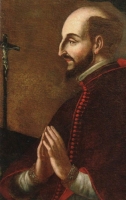
Antony
Born to the nobility; his family were French expatriates living in Italy. He earned a doctorate in civil and canon law at age 17, then studied in Rome, Italy. He served as a courtier to King Philip III in Madrid, Spain. Ordained a priest in 1610, Father Antonio became royal chaplain to Philip III for ten years. Bishop of the territorial prelature of Santa Lucia del Mela, Italy, confirmed by Pope Paul V, from 12 November 1616 until his death nearly 10 years later. Counselor and chaplain to the court of the kingom of Sicily. For all his time spent in royal and noble courts, Father Antonio was known to his ascetic life, sleeping on the bare ground or floor, eating little and plainly; he was noted for his concern for piety and penance, a ministry to the poor and sick, and work with people who were victims of loan sharks.
26 September 1585 in Naples, Italy
• 2 September 1626 in Santa Lucia del Mela, Messina, Italy
• incorrupt remains enshrined in the basilica of Santa Lucia del Mela
• 2 September 2013 by Pope Francis
• beatification recognition celebrated in the Co-Cathedral of Santa Maria Assunta, Santa Lucia del Mela, Messina, Italy, presided by Cardinal Angelo Amato
https://catholicsaints.info/blessed-antonio-franco/

• Agricola of Bologna
• Agricol, Agricolus
Son of Saint Magnus of Avignon, a Gallo-Roman senator who became a monk and then bishop of Lerins, France. Agricola moved to Lerins at age 14 and became a Benedictine monk there at age 16. He was ordained a priests in Lerins. Co-bishop of Avignon with his father in 660. Bishop in 670. He built a church and Benedictine convent in Avignon, the church staffed with his brother monks. Noted preacher, he was known for his charity and defense of the poor and sick against civil authorities. His blessing ended an invasion of storks, leading to his patronage of them, and his emblem in art. His prayers were said to produce rain, good weather and fine harvests.
c.625 in Avignon, France
• c.700 of natural causes
• buried in the chapel of Saint Peter the Apostle in the cathedral of Avignon, France
• against misfortune
• against plague epidemics
• for rain
• for good weather
• storks
• Avignon, France, city of (named in 1647)
• Avignon, France, diocese of
stork(s)
https://catholicsaints.info/saint-agricola-of-avignon/
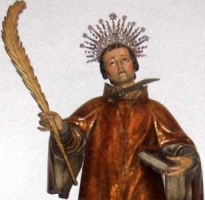
• Antonin, Antoní, Antolin • Apostle of the Rouergue
• 18 May (translation of relics to the Diocese of Palencia, Spain)
• 19 June (translation of relics to Pamiers, France in 887)
• 9 November (Coptic calendar)
First century convert, first to an Arian form of Christianity, then to the orthodox form. Pilgim to Rome, Italy where he studied and was ordained a priest. He became a travelling preacher in Italy, and served as a parish priest in Salerno, Italy for 18 years. Missionary to the Aquitaine region of modern France, which led to his title Apostle of the Rouergue. Miracle worker.
at Fredelacum, Gaul (modern Pamiers, France)
• stabbed in the area of his neck in Vallis Nobilis, Gaul (modern Saint-Antonin-Noble-Val, France)
• some relics in the Catedral de san Antolín of the Diocese of Palencia, Spain, which was dedicated to him in 1172
• some relics in Palencia, Spain
• Chiusa de Pesio, Italy
• Medina del Campo, Spain
• Palencia, Spain
• Pamiers, France
https://catholicsaints.info/saint-antoninus-of-pamiers/

• Elpidius of Cappadocia
• Elpidius the Abbot
• Elpidius the Hermit
• Elpidio....
Monk. Abbot in Asia Minor. Hermit in a cave on Mount Luca, Cappadocia for over twenty years. Legend says that an angel convinced him to immigrate to the area of Ancona, Italy where his reputation for holiness and wisdom attracted many disciples.
Cappadocia
• 4th century of natural causes
• relics enshrined in the town of Cluana (modern Sant'Elpidio a Mare), Ancona, Italy in the 7th century
• the relics are believed to have saved the town from a Lombard siege when Elpidius appeared in the sky asking the inhabitants to defend the village
• Sant'Elpidio a Mare, Italy
• Sant'Elpidio Morico, Italy
man with a vine leaf in winter which recalls a story of him planting a twig in bare ground in winter - and the resulting vine grew so fast and full and that it covered the whole church beside it
https://catholicsaints.info/saint-elpidius-the-cappadocian/
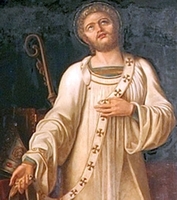
Just, Justo, Giusto
• 4 August (translation of relics in Lyon, France)
• 14 October (translation of relics)
Deacon at Vienne, France. Priest. Bishop of Lyon, France c.350. He presided over the Council of Aquileia in 381, strongly opposed the heresy of Arianism, and became a friend of Saint Ambrose of Milan.
When a violently insane criminal sought sanctuary in the cathedral of Lyon after attacking people in the street, the man was seized and killed by an avenging mob who ignored the sanctity of the church and the tradition of sanctuary. Justus was so disillusioned with the people, and what he considered his failure to bring them the real faith, that he left his see. He and Saint Viator of Lyon spent the rest of their days as prayerful hermits in the desert near Alexandria, Egypt.
at Vivarais, Gaul (in modern France)
• 390 in the Egyptian desert of natural causes
• relics returned to Lyon, France
• buried in the cemeterial basilica of the Machabees in Lyon
https://catholicsaints.info/saint-justus-of-lyon/

Albert Prezzati
5 September (Benedictines)
Born to the Italian nobility. Soldier in the army of Bergamo, Italy. Severely wounded in battle, he made the common offer to God that he would enter religious life if he was healed. Albert recovered, made a pilgrimage to Santiago de Compostella, became a Benedictine monk, and c.1079, he returned to Pontida, Italy where he founded the Cluniac abbey of Saint James. Its first abbot was Blessed Vitus of Pontida who served while Albert studied the Cluniac reform in France. When Vitus died, Albert took over for as the second abbot.
11th century Pontida, Italy
• 2 September or 12 September in 1095, 1096 or 1099 (records vary) of natural causes
• relics interred with those of Blessed Vitus of Pontida at the church of the abbey of Saint James in Pontida, Italy
• following a fire at the abbey church, relics moved to the church of Santa Maria Maggiore in Bergamo, Italy in 1373
• relics returned to the abbey in Pontida in 1911
https://catholicsaints.info/blessed-albert-of-pontida/

• William of Denmark
• William of Roschild
• William of Roskilde
• Wilhelmus...
Priest. Court chaplain to King Canute of England and Denmark. During a trip to Denmark, William saw a crying need for Christian missionaries in the area, and he worked there the rest of his life.
Bishop of Roskilde, Zeeland. He decreed that a person who had shed blood unjustly could not receive the sacraments until he had done public penance. King Sweyn, who was one of the targets of this order, came to the cathedral with armed men determined to have his own way and show that the king ruled, not the Church. William stood in the door, armed only with his crosier. When the guards threatened to attack him, William offered no resistance. Sweyn was shamed, asked forgiveness, and gave the church a gift of lands in token his penance.
Anglo-Saxon
1067 of natural causes
https://catholicsaints.info/saint-william-of-roskilde/

Bishop of Tarragona, Spain c.693. In 711, ahead of Muslim invaders, Prospero packed up the cathedral's liturgical books and the relics of Saint Fructuosus of Tarragona and other martyrs, and fled Spain with his cathedral priests, Giustino and Procopio, and cathedral deacons, Marziale, Pantaleone and Giorgio. They travelled to Italy, first to Cagliari in Sardinia, but settled on the coast of the region of Liguria near Genoa. Prospero founded the Benedictine monastery of Capodimonte whose church enshrined the relics the group had brought with them, and where they were all subsequently buried in their time.
Spain
c.715 in Tarragona, Spain of natural causes
• Pre-Congregation
• on 4 May 1854 Pope Pius IX approved the veneration in the parish church of Camogli, Italy
https://catholicsaints.info/saint-prospero-of-tarragona/

Brocardo, Brocardus, Burchard, Brochard
Monk on Mount Carmel who was chosen prior of his house. Around the year 1210, he asked Saint Albert, patriarch of Jerusalem, to write a Rule for the monks. This Rule became the foundation for the Carmelite Order. Pope Honorius III objected to its use because it did not have his prior approval. The Pope received a vision of the Blessed Virgin Mary who supported the rule; Honorius gave his approval. Brocard ruled his house for 35 years, setting an example for devotion to the Rule, and gaining great respect from the region's Muslims.
French
1231 of natural causes
added to the Carmelite breviary in 1564
https://catholicsaints.info/saint-brocard/
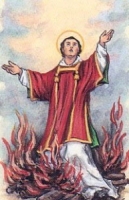
Abibo, Abbibos, Abibos, Abbibus, Habib
Fourth-century deacon in Edessa, Syria. Friend of Saint Shamuna of Edessa and Saint Gurias of Edessa, he escaped execution in the persecutions of Galerius in which Shamuna and Gurius died. When imperial tolerance was declared for Christianity in 311, Abibus returned to the city and his ministry. Eleven years later, in the persecutions of Emperor Licinius and governor Lisania, he was arrested, tortured and finally executed. Martyr.
• burned at the stake in Edessa, Syria in 322
• though he died, his body did not burn up, and he was buried next to Saint Shamuna of Edessa and Saint Gurias of Edessa
https://catholicsaints.info/saint-abibus-of-edessa/
Heiu
Nun, receiving the veil from Saint Aidan of Lindesfarne. Abbess of Hartlepool Abbey in 640. Abbess at Tadcaster, Yorkshire, England, the first woman to rule a double monastery. Some writings identify her with Saint Bega.
early 7th century Northumbria, England
c.657 in Healaugh, Yorkshire, England of natural causes
In Tadcaster's Monastery, O Abbess Hieu, thou didst shine with the virtues of asceticism and humility. Pray that we also may follow the example of thy great teacher, the Hierarch Aidan, and live lives of spiritual struggle that our souls may be saved. - troparion of Saint Hieu
https://catholicsaints.info/saint-hieu/

Apostle of Devotion to the Holy Family
Priest. Poet. Member of the Sons of the Holy Family. Preached devotion to the Holy Family in the pulpit, the press and the confessional. Killed in the anti–Christian persecutions of the Spanish Civil War.
19 September 1867 in Santa Fe, Lleida, Spain
• 2 September 1936 in Cervera, Lleida, Spain
• buried in a common grave in Cervera
13 October 2013 by Pope Francis
https://catholicsaints.info/blessed-joan-franquesa-costa/

• Comus of Candia
• Cosmas, Kosmas
20 April (translation of relics)
Monk. An opponent of the monothelite heresy, he withdrew from the world to become a naked, barefoot hermit on the island of Candia (modern Crete).
• c.706 on Crete (in modern Greece) of natural causes
• relics enshrined in the church of George the Great in Venice, Italy
https://catholicsaints.info/saint-comus-of-crete/
Guido, Vito
5 September (Benedictines)
Benedictine monk. Friend and fellow student of Blessed Albert of Pontida. First abbot of the Cluniac abbey of Saint James in Pontida, Italy.
• relics interred with those of Saint Vitus at the church of the abbey of Saint James in Pontida, Italy
• following a fire at the abbey church, relics moved to the church of Santa Maria Maggiore in Bergamo, Italy in 1373
• relics returned to the abbey in Pontida, Italy in 1911
https://catholicsaints.info/blessed-vitus-of-pontida/
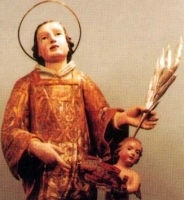
Antoninus of Apamea
9 September (Byzantine calendar)
Stone mason in predominently pagan Aribazus, Syria. He denounced their non-Christian practices of neighbors, and became a hermit for two years. He then returned to his village and destroyed the pagan idols there. He afterwards moved to Apamea, Syria where he built a church. Martyr.
4th century in Apamea, Syria
https://catholicsaints.info/saint-antoninus-of-syria/
Lesé, Lezens, Léziers, Licerius, Licinio
Soldier. Martyr.
Spain
• 9th century Mas d'Auvignon, France
• relics enshrined in at reliquary and white marble tomb in the church of Saint Martin in Lectoure, France
• records indicate devotion by 1517
• cultus confirmed at the diocesan level in the 18th century
• cultus confirmed by Archbishop Nicolas-Augustin de la Croix d'Azolette of Auch, France in 1841
https://catholicsaints.info/blessed-licinius/
Teodota, Theodote
Born to the nobility, Theodota was a Christian woman who as married and became the mother of three saints - Evodius, Hermogenes and Callista. Widow. When she refused an offer of marriage by imperial prefect Leucatius during the persecutions of Diocletian, he denounced her as a Christian, had her arrested, beaten and executed. Martyr.
thrown into a furnace in 304 in Nicaea, Bithynia (in modern Turkey)
https://catholicsaints.info/saint-theodota-of-bithynia/

• Eleazar the Priest
• El'azar, Eleàzaro, Eleàzar, Eleasar
Third son of Old Testament Patriarch Aaron. Leader of the Jewish theocracy. With his brother Ithamar, he founded the Israelite priestly class. Old Testament patriarch.
https://catholicsaints.info/eleazar-the-patriarch/
Siacre, Siagrio
Bishop of Autun, France c.560. Known for his learning and zeal for the faith in the councils he attended, and was greatly admired by Pope Saint Gregory the Great.
• c.600 of natural causes
• some relics enshrined at Val-de-Grace, Paris, France
https://catholicsaints.info/saint-syagrius-of-autun/
Elpidio, Elpèidius
Bishop of Lyon, France from 410 until his death 12 years later.
• 422 of natural causes
• relics in the church of Saint Justus in Lyon, France
https://catholicsaints.info/saint-elpidius-of-lyon/

Fifth century bishop of Vercelli, Italy for nine years.
https://catholicsaints.info/saint-lanfranco-of-vercelli/
Massima
Slave in imperial Rome. Martyred with Saint Ansanus in the persecutions of Diocletian.
scourged to death in 304 in Rome, Italy
https://catholicsaints.info/saint-maxima/
Early martyr.
whipped to death in Adrianopolis, Thrace (an area of modern Bulgaria)
https://catholicsaints.info/saint-aithalas-of-adrianopolis/
Early martyr.
whipped to death in Adrianopolis, Thrace (an area of modern Bulgaria)
https://catholicsaints.info/saint-ammun-of-adrianopolis/
Fourth Bishop of Strasbourg, Alsace, France in the 4th century.
4th century
https://catholicsaints.info/saint-valentine-of-strasbourg/
Bishop in Scotland.
c.1034
https://catholicsaints.info/saint-lolanus/
Honors all the bishops of the Diocese of Rennes, France who have been recognized as saints and beati. They include -
https://catholicsaints.info/holy-bishops-of-rennes/
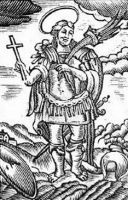
Three Christians who were martyred together in the persecutions of Diocletian. No details about them but their names have survived – Concordius, Theodore and Zenone.
Nicomedia, Bithynia (in modern Turkey)
https://catholicsaints.info/martyrs-of-nicomedia-2-september/
A group of ten Christian martyrs; their names are on old martyrologies, but we have lost all record of their lives and deaths.
• Antoninus
• Diomedes
• Eutychian
• Hesychius
• Julian
• Leonides
• Menalippus
• Pantagapes
• Philadelphus
• Philip
https://catholicsaints.info/martyrs-of-2-september/
Thousands of people were murdered in the anti-Catholic persecutions of the Spanish Civil War from 1934 to 1939. I have pages on each of them, but in most cases I have only found very minimal information. They are available on the CatholicSaints.Info site through these links:
• Blessed Baldomer Margenat Puigmitja
• Blessed Fortunato Barrón Nanclares
• Blessed Joan Franquesa Costa
• Blessed José María Laguía Puerto
• Blessed Lorenzo Insa Celma
CatholicSaints.Info Portable Edition